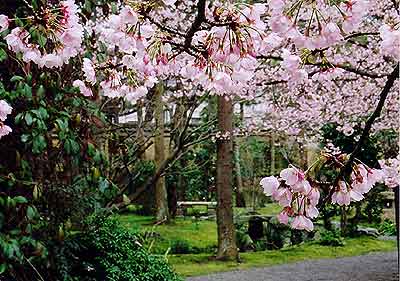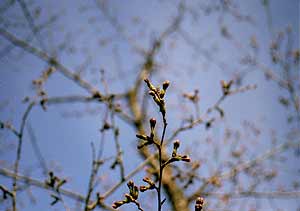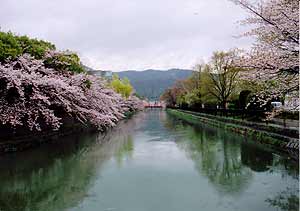
| Main Page |
| Photo Galleries |
| Writing |
| Aikido |
| Zen |
| Peeps |
| Links |
| Contact |

 Cherry
Blossoms
Cherry
Blossoms
 One
of the most anticipated times on the Japanese calendar is the Cherry Blossom
season, the true marker that spring has come.
One
of the most anticipated times on the Japanese calendar is the Cherry Blossom
season, the true marker that spring has come.
Cherry Blossom season marks the point where Japanese make a mass exodus from the cloistered confines of their homes and offices to take in the sight of nature making her annual resurgence following the long winter season.
The cherry blossom, or sakura, has found itself a place very close to the hearts of most Japanese, and in my opinion to see Japan in cherry blossom season is to see both the country and its people at their best. Trees that for the rest of the year seem ordinary, and even a little strange given their prominent positions in the landscape, suddenly erupt in a profusion of colourful blossoms. What were once pretty, but subdued, arrangements of trees suddenly come to life in a million shades of pink.
 What
is at first surprising is the sheer number of blossoms that each tree
seems capable of holding. Each branch becomes covered with countless thousands
of little flowers, so that they look like the boughs of a tree freshly
laden with snow.
What
is at first surprising is the sheer number of blossoms that each tree
seems capable of holding. Each branch becomes covered with countless thousands
of little flowers, so that they look like the boughs of a tree freshly
laden with snow.
What is more interesting still, however, is the incredibly short life of the blossoms. Each tree, once it has blossomed, stays in bloom for only a week before the petals begin to fly off in the wind. Herein, also, lies a part of the reason that the sakura has secured for itself such an enduring place in the Japanese psyche.
 Sweet anticipation: buds on a cherry tree just a week before they are ready to burst into bloom. The progress of the cherry trees throughout the country is enthusiastically followed in the news media by many Japanese. |
 The sweeping boughs of the cherry trees grace this river in Higashiyama with colour even on a drab, rainy day like this one. The whole city becomes dappled with pink in this season, adding much needed cheer after the winter. |
 In
many ways the cherry blossom has been revered because of the close resemblance
it has to the ideals of the Japanese way of life. Samurai often used the
brief but brilliant lives of the blossoms as an exemplar for their own
lives, wanting nothing more than to shine radiantly for a short time and
to fall without suffering the slow degeneration of age. The Japanese death
aesthetic owes a great deal to the cherry blossom for its imagery.
In
many ways the cherry blossom has been revered because of the close resemblance
it has to the ideals of the Japanese way of life. Samurai often used the
brief but brilliant lives of the blossoms as an exemplar for their own
lives, wanting nothing more than to shine radiantly for a short time and
to fall without suffering the slow degeneration of age. The Japanese death
aesthetic owes a great deal to the cherry blossom for its imagery.
On a lighter note, cherry blossoms have also furnished generations
of Japanese with an excuse to get drunk. Cherry blossom season also means
having a hanami, or 'flower viewing party'. This generally involves
a large blue tarp, a tonne of food and copious amounts of beer and sake.
Revellors spread their  tarp
under any of the many trees in bloom throughout the city and hunker down
to an extended period of drinking and eating. In this respect the trees
are more of a backdrop than a focus, and given the amounts that most people
drink, they would likely be seeing little pink blossoms by the end of
the night whether they were in bloom or not.
tarp
under any of the many trees in bloom throughout the city and hunker down
to an extended period of drinking and eating. In this respect the trees
are more of a backdrop than a focus, and given the amounts that most people
drink, they would likely be seeing little pink blossoms by the end of
the night whether they were in bloom or not.
The funny thing is that competition for the best spots has become such that many companies will dispatch the youngest 'greeners' from the office early in the day to secure and hold a spot for the company picnic in the evening. It has become a common ritual in most companies these days, and is something of a rite of passage for new employees.
 In
the case of Daigo Temple(above), the place
is only as prominent as it is today because the old warlord Toyotomi Hideyoshi
favoured it as a good drinking spot during cherry blossom season. The
garden there still bears his 'signature'; a moss insignia integrated into
the rock garden depicting a sake jar and two cups.
In
the case of Daigo Temple(above), the place
is only as prominent as it is today because the old warlord Toyotomi Hideyoshi
favoured it as a good drinking spot during cherry blossom season. The
garden there still bears his 'signature'; a moss insignia integrated into
the rock garden depicting a sake jar and two cups.
Before seeing them for myself, I really couldn't understand why the Japanese always made such a big fuss about the cherry blossoms. Now I see what it's all about. They're gorgeous, it's a treat to get outside, and it's an excuse to have a party. Not bad, for a tree.